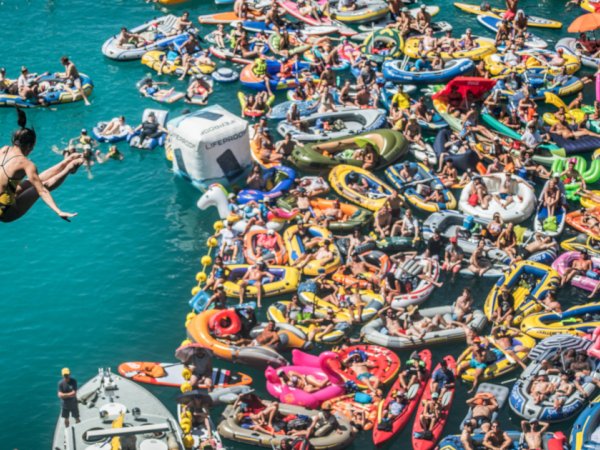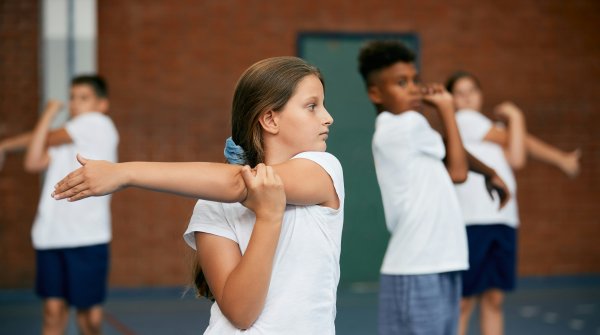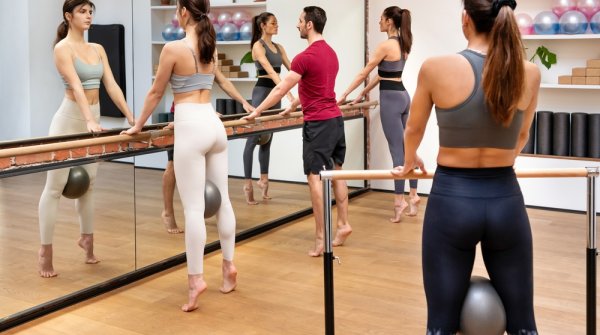She's standing up there for a long time. Too long. Sure, there's wind, but Anna Bader knows that. But no seagull screams as often at the sea. The spectators hold their breath anyway. Nothing but Swiss mountain air lies between her and her destination, Lake Lucerne, off the shores of the village of Sisikon.
Everything's going to go very fast in a minute. It takes her 2.6 seconds to get down 21 meters. With 75 km/h the petite athlete hits the surface of the water. Usually. But this isn't normal. Instead of pushing herself forward from the platform like a thousand times before, Anna Bader starts the retreat and aborts the attempt. The lake can sparkle with all its seduction. It just doesn't work. Mental block, no visualization. "I didn't see the jump," she'll say later.
And so she has no choice but to descend step by step, like one of those mouthy heroes in the pool, who doesn't dare to take on the ten meter platform after all. In ten years of the Red Bull Cliff Diving Series, they have never experienced anything like a professional simply not jumping. But when you look at it closely, the retreat is also more courageous than throwing yourself into the depths with a bad feeling. Cause it's gonna be really dangerous.
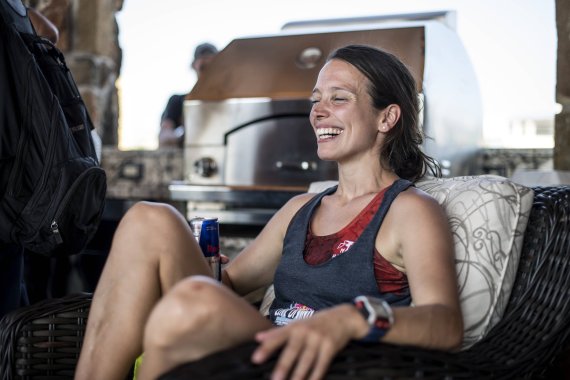
Two days before, the US athlete David Colturi had an accident at the same place, during a so-called teaser dive, which is supposed to make people want to see the event on the internet. But: accident doesn't really hit it. His landing wasn't perfect, but he got out of the water relaxed, posing for photos. Only in the evening did the prospective physician complain about being unwell, had himself taken to hospital - and lay on the operating table shortly afterwards: Ruptured spleen.
His profile on the website begins with the sentence: "I'm afraid of the potential consequences of a failed jump - almost as much afraid as a nine-to-five job." That's how they are, the Cliffdivers: sun on their faces and always a punchline at the ready.
That the cliché of the thoughtless, adrenaline-driven risk taker doesn't suit the best cliff jumpers in the world becomes clear to anyone who has ever risked a look from above. Only those who have all their senses together can get down from there in one piece. Up to four flips and corkscrews are added to make things more difficult. The men, who jump from 27 meters height, reach up to 90 km/h in impact. Their bodies are subjected to forces of two to three G, and even up to ten G when immersed. A belly flop from this height would be like landing on concrete from 13-meters.
Four years ago the Ukrainian Anatoliy Shabotenko landed on chest and face in training, had to be pulled from the water unconscious by the rescue divers - two days later he stood on the platform again for the competition. One suffered a pulmonary contusion, another shattered his wrist, and the coccyx of almost every athlete has broken at least once. Those who do not dive straight as a die will not be able to enjoy the next long-haul flight.
And yet they cannot and will not escape the rush, despite all fears. Serial winner Gary Hunt describes his crisis: "Once you have a mental blockade, it never really goes away. You have to learn how to handle it, and you'll grow with it. I'm not old Gary, I'm a different one now: Gary 2.0."
Rachelle Simpson, overall winner 2014, admits: "I'm afraid every time - and I'm so proud of myself when I overcome that fear. Then I think to myself, 'Wow! I can convince myself and other girls to do something like this, to face my fears!'"
Cliffdiving legend Orlando Duque can still rave as if he had just jumped off a cliff for the first time: "You feel the speed, this incredible acceleration - it's such fun."
And David Colturi says: "It is a liberating experience. Flying, without tools, without joystick, nothing, just the air, the water and you, fighting gravity on the way down, somersaulting, turning corkscrews. An existential experience with yourself, a connection with your environment. It's surreal."
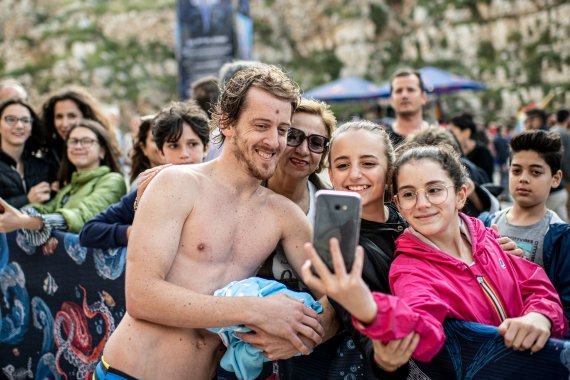
And pure stress. After Anna Bader had stopped her jump, she could have entered the competition again the next day. She refused. What she experienced on the first jump is enough for her. The nightmare of every cliff jumper: to lose orientation during the jump. "To clearly perceive where you are in every phase: That's the be-all and end-all with Cliff Diving," explains the mid-thirties, "there's nothing worse than flying around without control. I'd rather hurt myself a little."
You can't afford a more serious accident anyway, says Bader: "That's a bad dent for your self-confidence. Even the jumps you completely got, you won't dare anymore. It's always a balancing act, especially with new jumps. All the risks go through your head, everything that can go wrong. You know what can happen. We're not stupid, we know the impact and the speed."
The head, not the height, is the real opponent of the cliff diver. "Sometimes I wake up at night and think about the jump," says Bader, "then I have to turn it all off and say: 'I trained for that, I just have to retrieve it, do nothing else, don't lose my nerve. I can do it! I see the jump, I know exactly how it must feel.' Then you get on the board, and there's no doubt about it." And if there is, it's better not to. Otherwise, it could be the last jump.
In the early days cliff diving was mainly known from Acapulco: La Quebrada, the legendary 24 meter high rock from which the Clavadistas, the professional cliff jumpers, have been plunging into the depths since 1934 as a tourist attraction. By head jump, because of the overhanging rocks. Important for survival: take off at the right moment, because the Pacific is only deep enough there when a wave is rushing in.
But it is even more borderline: In August 2015, the extreme athelete Lazaro Schaller jumped from 58.8 meters at the Cascada del Salto waterfall near Maggia in Switzerland, higher than the Leaning Tower of Pisa. Impact at 123 km/h. It's hard to believe: from ten meters you need about three meters of water depth, but from 50 meters four meters is enough.
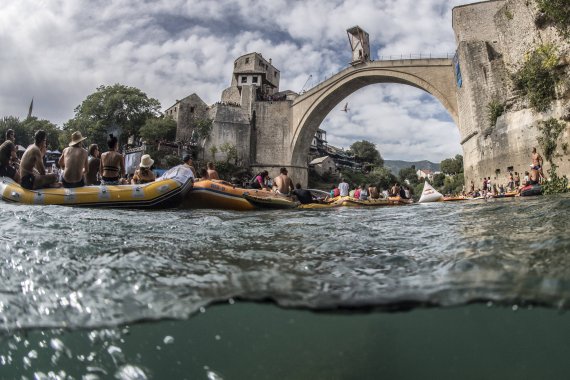
Only three or four dozen athletes worldwide practice this complex, physically and mentally demanding sport on a professional basis. That's a good thing. As spectacular as flying from the rocks is, it is life-threatening for untrained imitators. Since 2009, the Red Bull Cliff Diving Series has been a competition format that on the one hand leaves nothing out to stage the spectacle perfectly and on the other hand does everything for the safety of the athletes.
Three rescue divers are always in the water when the jumpers come in, an ambulance is in the immediate vicinity, the area is cordoned off, and people jump not from a narrow piece of rock, but from a stable platform - with one exception: On the Azores island of São Miguel it goes directly from the volcanic rock into the Atlantic.
Those locations: Sometimes the athletes dive in the Irish wilderness on the island of Inis Mór into a twelve degree cold rock basin, sometimes into the river water under the Stari Most, the world-famous bridge of Mostar, sometimes at the Chilean Riñinahue waterfall, surrounded by snow-covered volcanoes, sometimes from the castle in Malcesine, sometimes at the foot of Fujiyama, between the skyscrapers of Dubai, in front of the Guggenheim Museum in Bilbao, in the Thai Krabi, even in dust-dry Oman, a suitable wadi was found: Cliff jumping in the desert - you don't treat yourself to anything else.
The competition is particularly atmospheric in Polignano, a cute little town south of Bari. The houses seem to grow out of the cliffs and stand so vertically above the sea that the professionals were allowed to jump one after the other from different balconies for the teaser dive: Domino Dive. In a video Gary Hunt gets up from bed in the morning, stretches - and jumps out of the window: Wake-up-Dive.
The competition platform is accessed through the apartment of Piero L'Abbate, an elderly gentleman who watches the goings-on with his mother from his living room. The pictures of his terrace go around the world, because here the athletes prepare themselves, tear a few jokes ("Nice swimming trunks, Gary!") to fight the nervousness, go a bit too crazy on Instagram live, already push in the mouthguard or lay down on the fakir board like the Russian Artem Silchenko.
Sports director Greg Louganis, the world's best water diver in the 80s and 90s, gives interviews on the platform, so to speak in the face of the abyss, but only to reporters secured by climbing harness, which makes them look quite embarrassing next to the cool Greg.
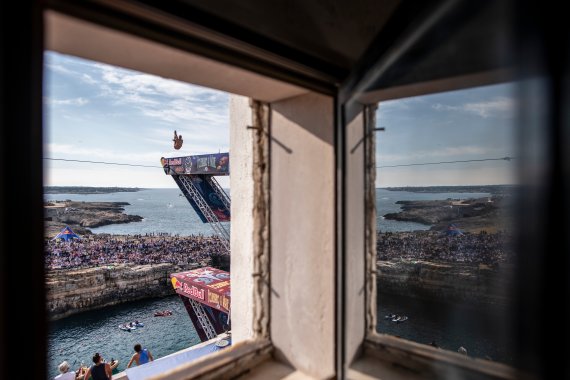
Then it gets serious: onto the platform, cheering of the thousands of fans down in the water and on the rocks, dropping the flip-flops down, checking the wind, thumbs up to the jury and the divers. Then a little bell rings, it gets quiet. Concentration. Some jump forward, others astride, some from the handstand, others run. Three seconds later they hit the water, toes first, arms tight to the body, otherwise it will be painful. Almost everyone wears a bandage on the knee, ankle, shoulder or wrist.
They must show four different jumps on the two competition days, execution and degree of difficulty will be evaluated by the five-member jury. Acclaimed and escorted by security men like rock stars, the atheletes then walk through the town, back to Piero's terrace, some accept an espresso offer on the way.
The overall winner receives the King Kahekili trophy, named after the Hawaiian chief who was the first to jump from the sacred cliffs of Kaunolu in the 17th century, the birthplace of this sport.
The High Diving World Championship of the World Swimming Federation Fina works according to the same pattern. They copied the format including the jump heights and the difficulty levels brought into a table. The inclusion in the Olympic program is also being considered. For Anna Bader, Cliff Diving is like ballet: "It's about grace, turns, free floating - and sometimes about sore feet." After all these years she wonders again and again "what you can do in two and a half seconds! The concentration is so razor sharp".
She learned the perfect body control during gymnastics from her mother Angelika, Olympic participant in 1968 and 1972. Anna became German team champion at 18, but had already started water jumping at 13. "Even as a child I jumped from trees into the lake," she remembers. Then at 17, the first big cliff, in Jamaica. Seven times she became European champion in water jumping, once third at the World Cup, landed in Macao at "House of the Dancing Water", the biggest Aquatic show worldwide. "That was great, my dream. When I was a kid, I always wanted to go to the circus." Two performances a day, five days a week: trapeze, choreography, pirate bride, costume change, the works. "Physically and mentally, it was hard."
She did this for four years. Then Red Bull opens the Cliff Diving Series for women - and Bader is there right away. 21 meters instead of the usual ten: Where do you train jumps from this height? The answer is as simple as it is scary: nowhere.
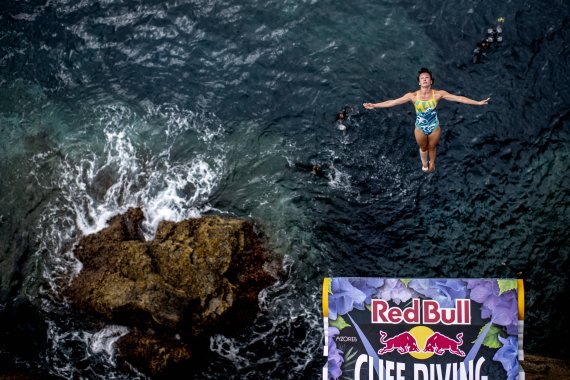
"Many jumps are similar to the ten meter platform," explains Bader, "the timing in the first half of the jump is almost the same, and then you hang on to the Barani." The Barani, named after an Italian acrobat from the 19th century, is the final turn before the impact. "With the Barani, you can see the surface of the water and time it again: accelerate or brake by bending your legs or raising your arms."
She jumps few repetitions, because the load for the body is so high. 30 to 40 jumps per week, only four or five on competition day. "This is all very intuitive. You need these phases of rest, and you feel different every day." Sometimes you feel like not jumping at all, see Sisikon. And then again free as a bird, says Bader: "I once tried out a new jump that not many people in the world could do at that time. But I knew I could do it. I could do it too, but I had too little rotation and fell on my face. It looked bad. "Yet I was the happiest person in the world."
She is even happier when her daughter Roksana is born a few years ago. The father: Kris Kolanus, a Pole, son of a diving instructor and an acrobat. Occupation: Cliff Diver. "I always found him a bit funny, introverted, hard to read," says Bader, "honestly, not much could be done with him." That changed when they spent a lot of time together at the High Diving World Championship in Kazan - and now they are the first Cliff Diving family to travel from cliff to cliff through the world, mostly with a grandma as babysitter.
That her parents regularly fall from the sky is "completely normal for the little one," says Mama Bader, "who thinks all parents are cliff jumpers." Seven months after his birth Bader jumps again - but differently than before: "I don't do the riskiest stunts. In the old days, I always wanted to make new jumps, sound out the boundaries. Through Roksi I had to switch, jump my simple program that I can safely, without adrenaline and tension before the competition. I've always been a concentrated, thoughtful jumper, efficiently uncoiled my program. I can't do that anymore. You are constantly interrupted, your head is elsewhere, your priorities are shifted. It's a whole different training, a different life.
And since she recently became a mom for the second time, her life hasn't really become quieter. The possibility that she will be back on top of the board after the competition break next summer is expressly not excluded.
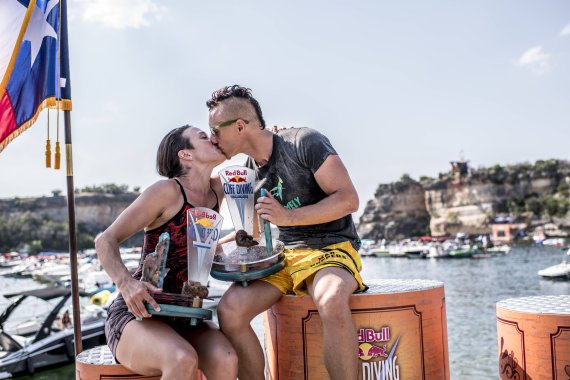
Why does an English and geography teacher (she failed the entrance examination for sports studies, failed sprint and football dribbling) put up with the stress? Not because of the money, anyway. Only two athletes can live of diving alone: six-time World Champion Gary Hunt and Red Bull-sponsored model type Orlando Duque. "The others improvise," says Bader. Just like her and Kris.
Together they created the swimwear label "Mad Hoppers" and invented a competition with a trampoline on the ten meter platform. It's how you get by. A shooting for Playboy on Mauritius in 2013 brought her media attention, but Bader didn't really feel comfortable with the photos: too far away from the sport. And she simply can't help it: "It's just fun, with all the thrills, all the fears. You never get comfortable, and it's a great feeling when a jump works. Sometimes I think, 'Phew, it's pretty high...' But after the first jump, you know why you're doing it."
Roksi is still on her mind, and then it becomes dangerous. On the Azores the little one was not allowed to go to the competition island, because she would not have been able to move alone in case of an evacuation. Bader had a babysitter for two hours, but she couldn't concentrate and returned to the hotel after just one jump.
"I was never a daredevil, always took good care of myself and tried not to hurt myself. It helped me practice the sport for so long. You have to listen to your intuition: What can I expect from my body? Where are the boundaries? A tenth of a second of distraction can be fatal."
And yet she may soon be standing on the platform again, up there at a height of 21 meters. A little wind will blow, maybe a few seagulls will scream, and the water will glitter seductively as always. Anna Bader will look down, think 'Phew...', gather, visualize the jump. And then everything will go very quickly. It has to.
- ISPO awards
- Mountain sports
- Bike
- Design
- Retail
- Fitness
- Health
- ISPO Job Market
- ISPO Munich
- ISPO Shanghai
- Running
- Brands
- Sustainability
- Olympia
- OutDoor
- Promotion
- Sports Business
- ISPO Textrends
- Triathlon
- Water sports
- Winter sports
- eSports
- SportsTech
- OutDoor by ISPO
- Heroes
- Transformation
- Sport Fashion
- Urban Culture
- Challenges of a CEO
- Trade fairs
- Sports
- Find the Balance
- Product reviews
- Newsletter Exclusive Area
- Magazine
